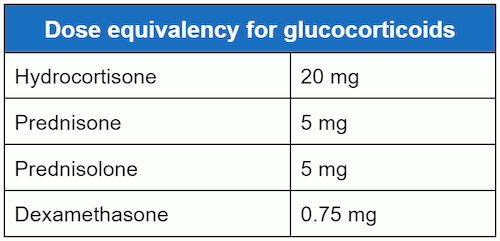Approach
Issues encountered in patients with corticosteroid-induced adrenal suppression include tapering of therapy, prophylaxis for stress situations, and treatment of overt clinical adrenal insufficiency.
Discontinuation of chronic corticosteroid therapy requires an individual approach, taking into consideration the risk of hypothalamic-pituitary-adrenal (HPA) axis suppression in each patient.[48]
Management of adrenal crisis
Patients with a history compatible with adrenal suppression and presenting with features of adrenal crisis (i.e., hypotension, circulatory failure) should be treated urgently.[38] If a diagnosis has not yet been established, it can be deferred until the patient is stabilised.
Hydrocortisone should be given intravenously or intramuscularly immediately, and then continued as an infusion or as intermittent doses. If improvement has occurred within 24 hours, which is common, the hydrocortisone dose can be decreased. This can be changed to an oral formulation whenever the patient is stable. The dose can be decreased by one third to one half the dose daily until a maintenance dose is attained.
Intravenous fluids, in the form of normal saline infusion, should be given to address the volume depletion that is often present.
A search for the condition that precipitated the crisis, such as infection, should be undertaken. Treatment of the underlying cause should be instituted.
Patients will not need mineralocorticoid replacement because the renin-angiotensin-aldosterone axis is intact.
Management of intercurrent stress in patients taking corticosteroids for underlying disease
Additional glucocorticoid administration is given to patients with adrenal insufficiency at times of stress due to the possible failure of cortisol secretion to cope with increased cortisol requirements, which may result in haemodynamic instability and the risk of adrenal crisis.[38][37] However, evidence for the timing and dosage of perioperative stress-dose corticosteroids is limited, even in patients with confirmed adrenal suppression, and will benefit from studies comparing different strategies.[49][50]
Minor stress
Patients experiencing minor intercurrent stress (e.g., febrile illness; minor procedure/surgery not requiring fasting such as tooth extraction or procedures that require local anaesthesia) should be instructed to double their chronic maintenance dose of corticosteroid on the day of the procedure or for the duration of illness.[1]
Severe stress
Patients who undergo severe stress situations (e.g., unable to take oral glucocorticoid, such as acute gastroenteritis or prolonged fasting for colonoscopy; surgery under general or regional anaesthesia; critical illness requiring ventilation; major trauma; active phase of labour and delivery) require parenteral corticosteroid (usually hydrocortisone).[1][51]
If patients are out of the critical phase of illness in less than 1 week but remain ill, then the dose of the corticosteroid can be tapered, using an oral formulation, back to previous pre-illness doses. The taper can be stopped sooner (i.e., at a higher dose) if the pre-illness dose is already achieved.
Stable patients taking corticosteroids for underlying disease: suitable for discontinuation or taper
As long as supraphysiological corticosteroids continue, evaluation of adrenal function is not helpful.[37]
Corticosteroid doses can be rapidly reduced to physiological replacement equivalents without fear of adrenal insufficiency. This corresponds to a dose of 20 to 30 mg/day of hydrocortisone or 5 to 7.5 mg/day of prednisolone. However, disease reactivation or the development of glucocorticoid withdrawal symptoms might dictate a slower tapering schedule.[Figure caption and citation for the preceding image starts]: Dose equivalency for glucocorticoidsCreated by MC Lansang and SL Quinn [Citation ends]. Once physiological replacement levels are reached, tapering should continue at a slower rate. At this point, many physicians prefer to switch to a product with a short half-life, such as hydrocortisone, because the fluctuating serum levels allow for greater HPA axis stimulation and recovery.
Once physiological replacement levels are reached, tapering should continue at a slower rate. At this point, many physicians prefer to switch to a product with a short half-life, such as hydrocortisone, because the fluctuating serum levels allow for greater HPA axis stimulation and recovery.
Reports on dose and duration of therapy resulting in adrenal suppression vary, and there are no good predictors of susceptibility.[52] Several tapering protocols exist.[52][53]
Joint European Society of Endocrinology/Endocrine Society guidelines make the following recommendations for tapering systemic corticosteroid therapy.[37]
Duration of corticosteroid therapy <3 to 4 weeks: tapering is unnecessary, regardless of the dose
Duration of corticosteroid therapy >3 to 4 weeks: corticosteroid dose >40 mg/day (prednisolone equivalent), decrement of 5-10 mg/day every week
Duration of corticosteroid therapy >3 to 4 weeks: corticosteroid dose <40 mg/day (prednisolone equivalent), smaller decrements are recommended:
Corticosteroid dose 20-40 mg/day: 5 mg/day decrement every week
Corticosteroid dose 10-20 mg/day: 2.5 mg/day decrement every 1 to 4 weeks
Corticosteroid dose <10 mg/day: 1 mg/day decrement every 1 to 4 weeks
Note that tapering of long-term glucocorticoid therapy should only be attempted if the underlying disease for which the glucocorticoid was prescribed is controlled, and glucocorticoids are no longer required.[37] In these cases, glucocorticoids are tapered until approaching the physiological daily dose equivalent is achieved (e.g., 4-6 mg/day prednisolone).
Use of this content is subject to our disclaimer